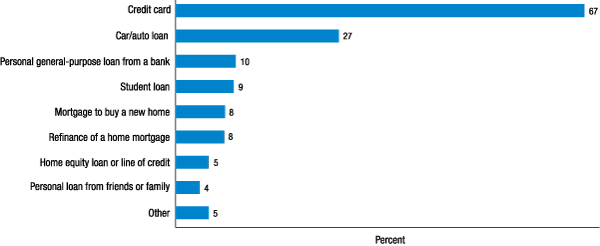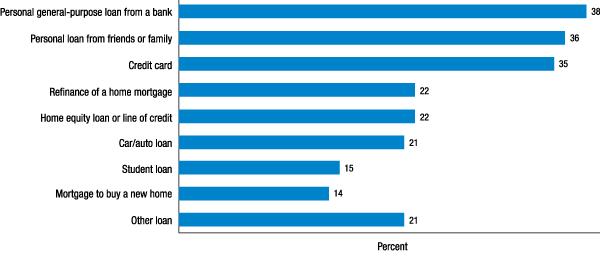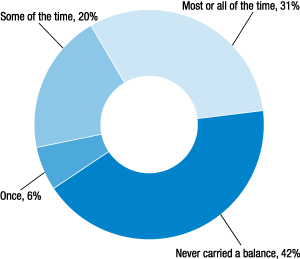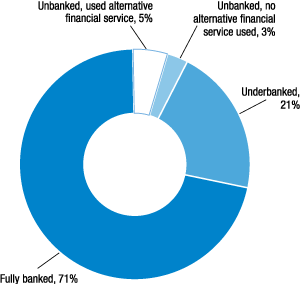Report on the Economic Well-Being of U.S. Households in 2015
- Preface
- Executive Summary
- Introduction
- Overall Economic Well-Being
- Income and Savings
- Economic Preparedness and Emergency Savings
- Banking, Credit Access, and Credit Usage
- Housing and Household Living Arrangements
- Automobile Purchase Decisions and Auto Lending
- Higher Education and Human Capital
- Education Debt and Student Loans
- Retirement
Banking, Credit Access, and Credit Usage
Banking and credit access can be important tools for wealth accumulation and for establishing the resources to withstand short-term economic hardships. The survey finds that lacking a bank account or using alternative financial services is prevalent among lower-income respondents. The results also show that a sizeable minority of those who applied for credit report that they had difficulties getting approved. However, despite the challenges that some face when trying to access credit, a majority of respondents do feel that credit would be available to them if they were to desire it.
Unbanked and Underbanked
Eight percent of adults in the survey are unbanked, meaning they do not have a checking, savings, or money market account.20 Nearly two-thirds of those who are unbanked report that they have, however, used some form of alternative financial service (AFS) in the prior year--such as a check cashing service, money order, pawn shop loan, auto title loan, paycheck advance, or payday loan. In addition to the 8 percent of adults who are unbanked, 21 percent are underbanked, defined as having a depository account but also using at least one alternative financial service in the prior year (figure 15).21
The likelihood of being unbanked or underbanked varies substantially by income, with lower-income adults being much less likely to have a traditional banking relationship (table 12). Among individuals with incomes under $40,000 per year, just over half (56 percent) are fully banked. This compares to 88 percent of those in the highest income group who are fully banked.
| Income category | Unbanked (no AFS used) | Unbanked (used AFS) |
Under- banked |
Fully banked |
|---|---|---|---|---|
| Less than $40,000 | 5.8 | 10.1 | 26.9 | 56.3 |
| $40,000-$100,000 | 0.9 | 1.5 | 19.5 | 78.0 |
| Greater than $100,000 | 0.5 | 0.4 | 11.1 | 87.7 |
| Overall | 2.9 | 4.9 | 20.6 | 71.1 |
AFS Alternative financial service.
In order to gain insight into the types of alternative financial services that individuals are using, the services can be broadly subdivided into borrowing and lending products (pawn shop loans, payday loans, auto title loans, paycheck advance, and tax refund anticipation loans); check cashing services; and money transfer services (money orders). By far, money transfer services are the most frequently used form of alternative financial service, with 77 percent of adults who used an alternative financial service indicating that they used either a money order or an international remittance. Just over one-third of those who used an alternative financial service in the past 12 months indicate that they used a check cashing service, whereas just over one-quarter used an alternative financial service to borrow money from the service provider.22
Credit Applications and Outcomes
The survey also inquires about respondents' applications for credit in the prior year. Thirty-nine percent of respondents have applied for some type of credit in the prior 12 months, up from 37 percent in 2014 and 31 percent in 2013. Among those who applied for credit, credit cards and auto loans were the most common application types, with 67 percent reporting that they applied for a credit card and 27 percent reporting that they applied for an auto loan (figure 16).

Note: Among respondents who applied for some form of credit in the past 12 months.
Twenty-six percent of respondents who applied for credit were denied credit at least once (10 percent of the entire population). However, some respondents who applied for credit also appeared to be limited in their credit access without receiving an outright denial--either by being offered less credit than they desired or by putting off a credit application because they expected to be denied (table 13).23
| Credit outcome | Yes | No |
|---|---|---|
| Denied credit | 26.0 | 73.7 |
| Offered less credit than applied for | 16.8 | 82.2 |
| Also put off applying for other credit because you thought you would be denied | 18.5 | 80.4 |
Note: Among respondents who report having applied for credit in past 12 months.
The rate of denial differs by the form of credit applied for. Personal loans and credit cards are the most commonly denied form of credit. Thirty-eight percent of those applying for a personal loan were denied or offered less credit than requested for at least one personal loan application. Among credit card applicants, 35 percent report at least one credit card denial or lower credit offer. In contrast, approximately 80 percent of applicants for each other form of credit indicate that their application was approved for the full amount requested (figure 17).
Figure 17. Respondents who received at least one denial or offer of less credit for each credit type among those applying for that type of credit

The rate of denial also differs by the family income of the respondent. Forty-eight percent of lower-income respondents who applied for credit were either denied or offered less credit than requested. Among respondents with an income over $100,000, one-in-five credit applicants report that they were denied or offered less credit than requested in the past year.
Additional Demand for Credit and Perceived Credit Access
A challenge with tracking the demand for credit and credit availability based on applications submitted is that the majority of adults do not submit an application in any given year. Recognizing this, the survey also includes questions on credit availability that are asked of all respondents and of respondents who did not apply for credit.
Some respondents who did not submit a credit application may have desired credit but opted against applying due to a perceived inability to obtain approval or for other reasons. When the respondents who did not apply for credit are asked whether they desired credit but did not apply, 12 percent report that they had a desire for additional credit. Fifty-six percent of those who desired additional credit indicate that they did not apply because they expected to be turned down or denied.
Among the entire adult population, just under half (46 percent) expressed a desire for additional credit in the prior year, either by submitting an application or by stating their desire for credit but not applying. Eighteen percent of all respondents--and 40 percent of those who expressed a desire for credit--indicate some real or perceived difficulty in accessing credit, either through an outright credit denial, being offered less credit than requested, or through an expectation of denial that caused them to put off some or all of their credit applications.
While the desire for credit is similar across income groups, the rate of denial and expected denial is substantially higher for lower-income respondents. Fifty-six percent of lower-income respondents who desired credit were either denied or offered less credit on one of their credit applications (21 percent), expected to be denied credit so did not apply (19 percent), or both (15 percent). In contrast, 34 percent of those with a family income between $40,000 and $100,000 and 23 percent of those in the highest income group who desired credit were either denied, offered less credit, or expected to be denied.
An alternate way to consider perceived credit availability is to ask respondents whether they feel that their credit application would be approved if they were to apply today. This allows for an assessment of credit availability among the entire adult population rather than only among those who applied or expressed a desire for credit.
Most adults appear confident in their ability to obtain a credit card if they were to apply for one. Three-quarters of respondents are somewhat or very confident in their ability to obtain a credit card, and over half are very confident in their likelihood of approval. However, consistent with that seen among those who desired credit, confidence in approval varies substantially by income (table 14). Fewer than one-third of respondents with a family income under $40,000 say that they are very confident that their credit card application would be approved.
| Income category | Very confident | Somewhat confident | Not confident | Don't know |
|---|---|---|---|---|
| Less than $40,000 | 32.4 | 25.2 | 32.0 | 10.2 |
| $40,000-$100,000 | 61.5 | 22.9 | 12.9 | 2.4 |
| Greater than $100,000 | 79.2 | 13.0 | 7.2 | 0.6 |
| Overall | 53.3 | 21.6 | 19.6 | 5.3 |
The lower rate of credit confidence among lower-income adults may partially reflect the large fraction of respondents in this income range who lack good credit. Less than half of respondents making under $40,000 per year rate their credit score as "good" or better. This compares to 90 percent of those in the highest income group who feel that they have good, very good, or excellent credit (figure 18). In general, respondents who report having poor, fair, or unknown credit also lack confidence in their ability to obtain a credit card, with only 32 percent feeling somewhat or very confident that their application would be approved. These results do not vary much by income level. Among those who believe their credit rating to be good or better, 94 percent of respondents feel that they would be approved, including 90 percent of borrowers in the lowest income group who rate their credit this way.

The survey results also indicate that confidence that a credit application will be approved is lower among non-Hispanic blacks and Hispanics than it is for non-Hispanic whites. Among white respondents, 60 percent are very confident that they would be approved for a credit card should they apply, compared to 35 percent of Hispanics and 39 percent of black respondents with this level of confidence. These differences in perceived credit access are consistent with those seen in the 2014 survey--which asked a similar question but focused on mortgage applications rather than credit card applications--and may be at least partially attributable to differences in income and other socioeconomic factors that also vary by race and ethnicity.
Credit Card Usage
In addition to exploring the availability of credit, the survey considers the ways in which individuals use credit cards. Overall, 77 percent of respondents report that they have at least one credit card. When asked how often they carry a balance on their card, 42 percent of those with a card report that they always paid their bill in full during the prior year. Just over half report that they carried a balance some, most, or all of the time (figure 19). Among the respondents who carried a balance at least once, approximately half indicate that they made only the minimum payment on their cards some or all of the time and 9 percent made the minimum payment once. The remaining 40 percent say that they always paid more than the minimum payment.
Figure 19. In the past 12 months, how frequently have you carried a balance on one or more of your credit cards?

Both access to a credit card and the use of a credit card differ substantially by the income of respondents. Only 59 percent of respondents with an income under $40,000 per year have at least one credit card, whereas 87 percent of those with an income between $40,000 and $100,000 and 94 percent of those with an income over $100,000 report having a card (table 15). Lower-income respondents with a credit card are also less likely to pay their bill in full each month and are more likely to indicate that they made only the minimum payment at least once.
| Income category | No credit card | Made only minimum payment at least once | Carried a balance at least once, but always pay more than minimum | Always paid in full |
|---|---|---|---|---|
| Less than $40,000 | 41.1 | 24.9 | 11.9 | 21.6 |
| $40,000-$100,000 | 12.9 | 29.1 | 22.0 | 35.9 |
| Greater than $100,000 | 6.3 | 24.9 | 21.6 | 47.3 |
| Overall | 23.2 | 26.3 | 17.6 | 32.5 |
Respondents who have carried a balance are also asked about the interest rate on the credit card that they use most often. Here, it appears that of those who carry a balance, lower-income respondents are less likely than others to know the interest rate that they pay and, among those who do know their interest rate, they often report paying a higher rate than respondents whose income is higher. Over one-fifth of individuals whose family income is below $40,000 per year and that carried a balance report that the interest rate on their main credit card is over 20 percent. In contrast, fewer than 10 percent of those in the highest income category that carried a balance report that their interest rate is at this level (figure 20).

Note: Among respondents who carried a balance at least once in the past year.
References
20. Among these respondents who do not have a checking, savings, or money market account, 63 percent use some form of alternative financial services, while 37 percent neither have a traditional bank account nor use alternative financial services. Return to text
21. The fraction of adults who are underbanked is higher than that observed in the 2014 survey due to a methodological change and is not directly comparable to the earlier results. In the 2015 survey, alternative financial services are examined by asking a series of questions that inquire about specific types of services rather than combining all services into a single question. These changes increased the probability of respondents reporting that they have used these services. The frequencies observed with this revised question are in line with those observed in the Census Bureau's Unbanked and Underbanked supplement to the Current Population Survey in 2013. Return to text
22. It cannot be observed, however, the extent to which money orders are being used to borrow or lend money to other individuals directly. Return to text
23. Respondents can select more than one adverse credit outcome or decision, so overall 35 percent of respondents were either denied outright, offered less credit, or put off applying for additional credit due to a fear of denial. Return to text

